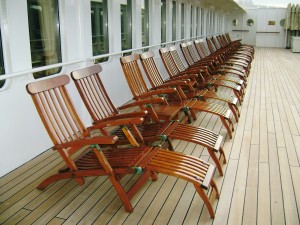Listening to some of the commentary regarding the end of the Second World War in Europe this coming week prompted a pretty unsettling realisation in me.
That being the deeply perturbing fact that QE2 has now spent longer laid up in Dubai than the entire duration of the mainland war in Europe and the Soviet Union. Stunning, but true.
In less time than she has slowly spent suffocating to death in the fly blown hell hole that is Dubai, Adolf Hitler conquered an empire that stretched from the North Cape to the African continent, and then lost it again.
So, should anybody ever again have the sheer, rank stupidity to complement the ridiculously fawned over sheiks of Dubai on their alacrity and business acumen, simply remind them of that slightly less than unfortunate truth.
There she lies, her fate in the hands of a shabby cabal of clueless, posturing fools who wanted her as a trophy, a status symbol. Now, they do not know what to do with her. Perhaps they never did in the first place.
Perhaps the robed mandarins of the desert kingdom simply over indulged themselves like the spoiled, pampered kids of unchallanged oligarchs to whom money is no object. A kind of bratterati if you will, spiritual paupers on an epic scale that can recognise a glittering trophy, purchase it, and suddenly not know what the hell to do with it.
So there they sit in their glitzy splendour, embarrassed and unsure what to do with what was once their most prized, heavily lauded prestige project. Fantastical, fulsome claims have given way to a veil of shameful silence that hangs over the suffocating Queen like a funeral pall.
There is no question that she deserves better; a ship that broke new ground as the first ocean liner cum floating resort. One that served her country in time of war and, most spectacularly, one that came to emphasise everything ‘great’ about Great Britain for three decades along with her true travel partner, the supersonic Concorde. This ship- breathtaking, elegant and groundbreaking- came to be adored and revered like none other, either before or since.
Sadly, what she deserves is most unlikely to be what she will get.
While she floats, there is always hope. But people need to get out there and ask awkward questions. The pompous, embarrassed burghers of Dubai need to be heckled, ridiculed, and held to account over their inept, ruinous, directionless and completely disastrous stewardship of one of the most singularly significant maritime icons ever to cut salt water.
How much time does she have? Who knows? Even the fickle, capricious clowns who hold ther life in their hands cannot say. Can not, or will not.
Let’s hope 2015 will provide smoother seas and kinder breezes for our loved, languishing lady. And yes, more than ever before, let’s pray the God does, indeed, save our gracious Queen.
Because the one thing you can bet on is that the cash sodden, status obessessed clowns in Dubai most certainly will not.








